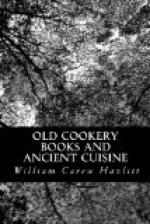The sugar of Cyprus was also highly esteemed; that of Bezi, in the Straits of Sunda, was the most plentiful; but the West Indian produce, as well as that of Mauritius, Madeira, and other cane-growing countries, was unknown.
Of bread, the fifteenth century had several descriptions in use: pain-main or bread of very fine flour, wheat-bread, barley-meal bread, bran-bread, bean-bread, pease-bread, oat-bread or oat-cakes, hard-bread, and unleavened bread. The poor often used a mixture of rye, lentils, and oatmeal, varied according to the season and district.
The author of “The Serving-man’s Comfort,” 1598, however, seems to say that it was counted by the poorer sort at that time a hardship only to be tolerated in a dear year to mix beans and peas with their corn, and he adds: “So must I yield you a loaf of coarse cockle, having no acquaintance with coin to buy corn.”
In a Nominale of this period mention is made of “oblys,” or small round loaves, perhaps like the old-fashioned “turnover”; and we come across the explicit phrase, a loaf of bread, for the first time, a pictorial vocabulary of the period even furnishing us with a representation of its usual form.
Nor were the good folks of those days without their simnels, cracknels, and other sorts of cakes for the table, among which in the wastel we recognise the equivalent of the modern French gateau.
Besides march-pain or pain-main, and pain-puff, two sorts baked on special occasions, and rather entering into the class of confectionery, our better-to-do ancestors usually employed three descriptions of bread: manchete for the master’s table, made of fine boulted flour; chete, of unboulted flour, but not mixed with any coarser ingredient; and brown-bread, composed of flour and rye meal, and known as maslin (mystelon).
A bushel of wheat, in a romance of the thirteenth century, is estimated to produce twenty loaves; but the statement is obviously to be taken with allowance. The manchet was sometimes thought to be sufficient without butter, as we now eat a scone. In the “Conceits of Old Hobson,” 1607, the worthy haberdasher of the Poultry gives some friends what is facetiously described as a “light” banquet—a cup of wine and a manchet of bread on a trencher for each guest, in an apartment illuminated with five hundred candles.
There is no pictorial record of the mode in which the early baker worked here, analogous to that which Lacroix supplies of his sixteenth century confrere. The latter is brought vividly enough before us in a copy of one of Jost Amman’s engravings, and we perceive the bakery and its tenants: one (apparently a female) kneading the dough in a trough at the farther end, a second by a roasting fire, with a long ladle or peel in his hand, putting the loaf on the oven, and a third, who is a woman, leaving the place with two baskets of bread, one on her head and one on her arm; the baker himself is almost naked, like the operatives in a modern iron furnace. The artist has skilfully realised the oppressive and enervating atmosphere; and it was till lately quite usual to see in the side streets of Paris in the early morning the boulanger at work precisely in the same informal costume. So tenacious is usage, and so unchanging many of the conditions of life.




